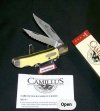- Joined
- Mar 4, 2019
- Messages
- 131
For my out-and-about food knife (this includes camping, and as I will be retiring soon hopefully a fair amount of travel & camping) my concept is a 2 blade, both full length blades.
One blade with a smooth edge for any cutting not against a plate. One blade lightly serrated only near the tip where it would touch a plate when cutting.
For a one blade knife the Opinel would likely be a fine knife. Thin blade. Looks good. Not expensive. Lock is a bonus.
One blade with a smooth edge for any cutting not against a plate. One blade lightly serrated only near the tip where it would touch a plate when cutting.
For a one blade knife the Opinel would likely be a fine knife. Thin blade. Looks good. Not expensive. Lock is a bonus.




